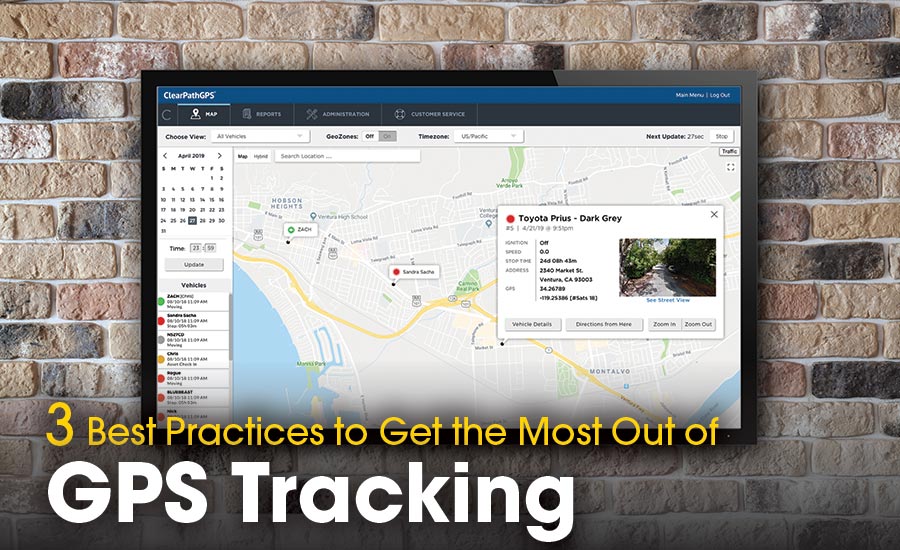So, you’re considering investing in GPS vehicle tracking for your fleet. Smart move: the right vehicle tracking software can help improve your customer service, increase the lifespans of your company’s trucks, and boost your bottom line in all sorts of other ways.
But rolling out a GPS solution is just the first step. How strategically your team uses the new system will make all the difference in how valuable it is — especially for an emergency response business like yours.
With that in mind, here are some best practices to help your company get the most from a vehicle tracking solution.
Best Practice #1: Display your real-time tracking map for everyone to see.
Any GPS tracking solution worth its salt will include an online map that gives you a real-time view of where all your vehicles are.
The map feature can work wonders to help a company’s dispatchers or customer service reps quickly spot the right driver to contact when a customer calls in with an emergency service request.
Thanks to the map, your team can immediately see which vehicle is closest to the new job site — and whether the field rep with that vehicle is free or in the middle of another job, in which case your dispatcher can just as quickly locate the next-closest driver, and so on…without having to call around.
But this map feature works only to the extent that your team uses it. And what if the person in your office who takes an emergency-service call isn’t one of your dispatchers and doesn’t have that real-time map in front of them?
Many companies have found it helpful to keep their live map up on a large wall monitor in the office, so anyone can see where every vehicle in the fleet is, and what their drivers are doing.
One ClearPathGPS customer that displays its vehicle tracking map on the wall is emergency response company QwikResponse. As co-owner Cheyne Knight puts it, “It’s fantastic to be able to reassure a customer who’s in a frazzled state that I can see exactly where the driver is, and I can tell you when they’ll get to your site.”
Best Practice #2: Help your drivers in the field with live traffic data.
If you’re in the emergency response business, one of the best ways to differentiate your company and earn customer loyalty is to consistently deliver on your promise to get there quickly when your customers need you.
But how your drivers get to job sites can be just as important as when they get there. After all, you don’t want your driver to make it in record time because he raced across town doing double the speed limit. That type of behavior can lead to tickets (which your company will have to pay for), and other scenarios you don’t want to think about.
If you’ve chosen the right vehicle tracking service, your team back at the office can help your drivers find the best routes, by simply overlaying live traffic information over your GPS map showing the vehicle’s position.
By the way, if a vehicle tracking service does not offer a live traffic overlay, that might be one clue that you need a different GPS solution.
Brian Dutter of Servpro Santa Barbara said, “Servpro works in a world filled with emergencies. You never know when the next call is going to come through for a house that has just suffered a fire loss or extensive water damage. In a business where our customers are frequently emotional, GPS vehicle tracking helps us to keep both our customers and our crews calm. We can also match up the right crew for the job and guide them to our customers as quickly as possible. It has been a big help for us to be able to assure our customers that help will be arriving quickly.”
Best Practice #3: Find ways to reward your most responsible drivers.
A telematics solution can tell you a lot more than just where your trucks are. It will also record detailed information about each vehicle minute-by-minute — like when a truck’s engine is idling, how fast it’s traveling, and whether the driver is braking, accelerating, or cornering aggressively.
This can all be valuable information for your business, for a couple of reasons.
First, when your drivers are in the field with your company’s vehicles, they’re representing your business and your reputation. Do you think seeing one of your trucks pulled over by a police car will inspire confidence in your company for passersby?
Second, knowing that a driver is being rough with your vehicles can also help you — pardon the pun — put the brakes on that behavior, which can help you extend the useful life of your vehicles and save your company from costly repair work.
One best practice we highly recommend is to offer incentives for your drivers to treat your company vehicles like they were their own. You can use financial rewards, company recognition, whatever you think will best motivate your drivers. Be creative.
Bottom line: GPS vehicle tracking can add real value to your operations and your business. But you’ve got to choose the right tracking solution, and you’ve got to use it properly. I hope the best practices I’ve suggested here can help your team.

